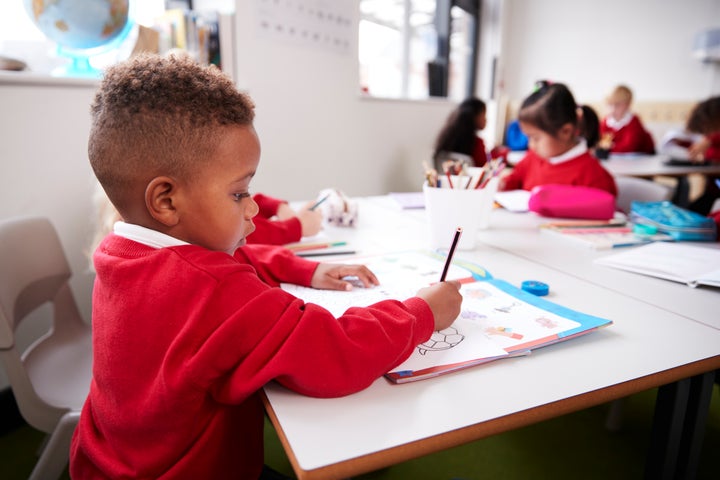
England’s state schools have a crisis of representation, with one white teacher for every 13 white pupils but less than a third of that ratio for Black and Asian students.
There were 43 Asian students for each Asian teacher and 42 Black students for each Black teacher during the 2019/20 school year, according to HuffPost UK analysis of data published by the Department for Education.
In many cities, particularly in the north of England, Black and Asian teachers are vastly underrepresented in the workforce. In Newcastle, just one in 100 teachers is Asian, compared to one in seven pupils, while Manchester has 159 Black students for every Black teacher.
Dr Remi Joseph-Salisbury, who last year led a report on racism in secondary schools for the race equality think tank The Runnymede Trust, said the figures for Manchester were remarkable.
“I know under-representation exists but hearing those numbers is just staggering,” he said, “particularly in such a racially diverse city.”
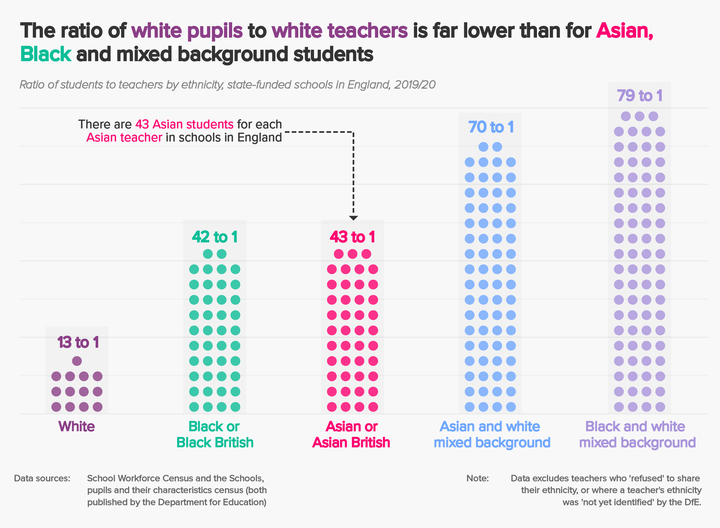
Dr Joseph-Salisbury said the teaching profession failing to reflect the diversity of students is a cyclical problem.
“Under-representation reproduces itself,” he said. “Young people in school don’t see [people who look like them] being teachers, so then potentially they don’t see teaching as a viable profession that they could go into.”
‘Nothing’s changed in 20 years’
Over the past decade, the share of teachers who were Black increased by just 2% per year. If that rate of change continued, it would take another 40 years for England’s teacher workforce to match the current diversity of pupils.
The disparity is even starker for Black headteachers, who currently make up 1% of bosses in state-funded schools. In comparison, 6% of pupils are Black.
Steve Chalke, founder of the Oasis Multi-Academy Trust, which runs 52 schools across England, believes that this “incremental progress” is insufficient.
“It’s no good saying, ‘Let’s all work for a 10% increase over the next five years,’ because that’s three [additional Black] headteachers. So what we need is a gear change.”
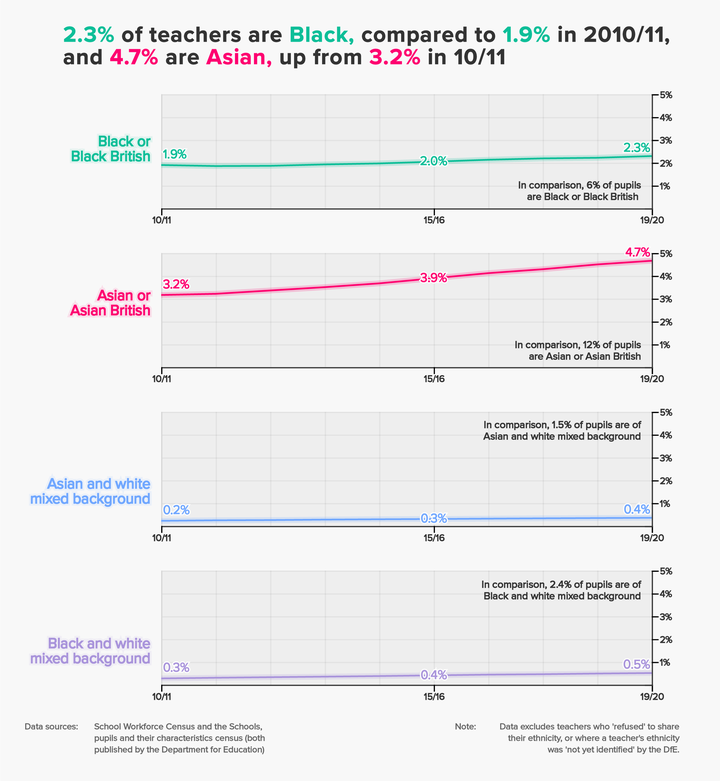
Chalke said Oasis is developing a teaching certificate for Black, Asian or minority ethnic (BAME) graduates and aims to provide them with teaching opportunities, support and leadership experience that will fast-track them into leadership roles.
“We want to positively discriminate towards Black graduates, particularly Caribbean top graduates, because we want to reflect the groups that do least well in education, and we want to give them great role models.”
Ava Sturridge-Packer, who was headteacher at St Mary’s Primary School in Birmingham for over 20 years, said that, since she was first appointed as a head teacher, the proportion of school leaders from minority backgrounds had not significantly changed.
“I feel positive in one way that conversations are happening,” she said, “but cautious in getting too excited because the conversations we’ve had since the George Floyd protests – these conversations were had 10 and 20 years ago, and nothing’s changed.”
“You cannot have a good conversation about structural racism without Black people participating in the room.”
- Steve Chalke
Sturridge-Packer said part of the problem is that there is not a voice in government who is “taking on these initiatives, having plain conversations and not hiding from the fact that the situation is stagnant”.
Chalke agreed that structural racism in the teaching profession was a “top-down problem”.
“The teaching community needs to be proactive in addressing it, and a multi-academy trust like Oasis has a huge responsibility to work hard at this, but I think that the government needs to work hard at it too,” he said.
“If you look at the senior leadership in terms of education in our country – the ministers and key civil servants responsible – you will discover that the vast majority of them are white.
“A bunch of middle-class white people – wonderful middle-class white people – cannot possibly feel or emphasise with or understand some of the issues and barriers and pain that somebody who is not white and middle class can feel.”
In other words, he said: “You cannot have a good conversation about structural racism without Black people participating in the room.”
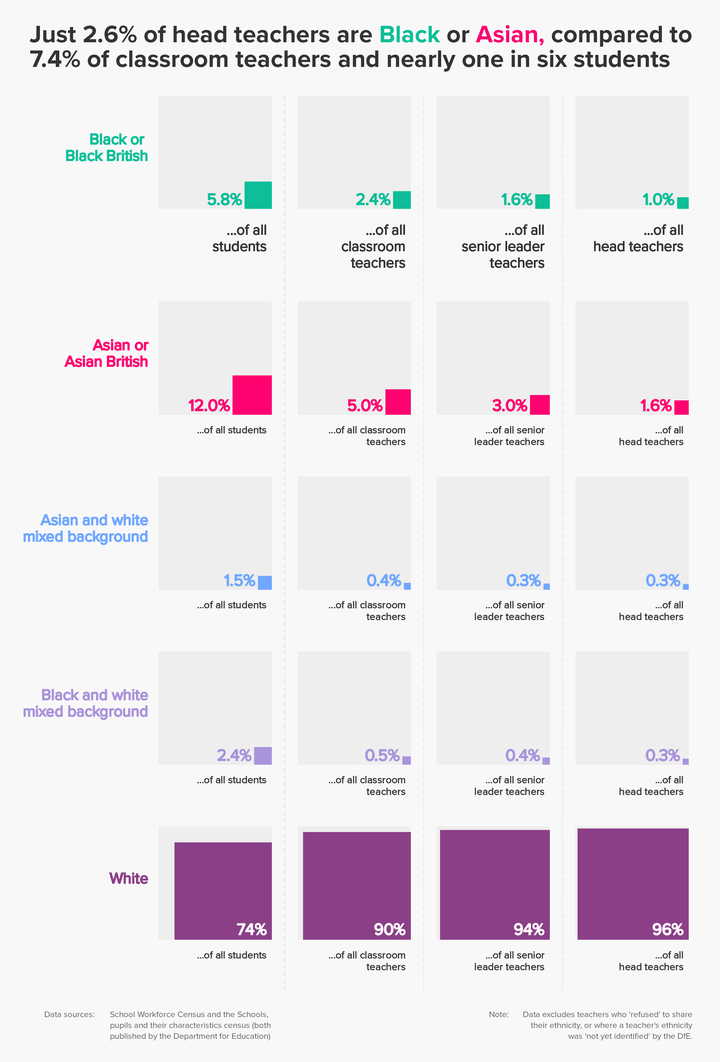
The UK has never had a single non-white education minister, and in 2019, just 4.8% of senior civil servants within the Department for Education were from an ethnic minority background. In June, Schools Week found that the management teams at the Department for Education, Ofsted and Ofqual were 97% white.
Black and Asian teachers make up the smallest share of the profession in the north-east, where 98% of teachers are white.
In Tyne and Wear – where 6% of pupils are Asian and 2% are Black – there were only 80 Asian teachers and four Black teachers employed during the 2019/20 school year, compared to over 9,000 white teachers.
Dr Joseph-Salisbury, who is the presidential fellow in ethnicity and inequalities at Manchester University, said having teachers that reflect the racial diversity of their students is important because of “the message that is transmitted to young people: who is seen to have the intellect and professionalism that qualifies them to be a teacher”.
He added: “We know that young people often look up to teachers and they want to see themselves represented by those teachers in a range of ways, and studies have shown that people of colour can be particularly inspired by seeing teachers of colour.”
“We often think about the message that [poor representation] transmits to people of colour, but it also transmits a message to white students”
- Dr Remi Joseph-Salisbury
But Dr Joseph-Salisbury added that a racially diverse teacher workforce did not only benefit minority ethnic pupils.
“We often think about the message that [poor representation] transmits to people of colour, but it also transmits a message to white students. They don’t see people of colour in those professional, supportive, intellectual positions. And then there’s a real danger that they derive meaning from that – that Black people are not capable of occupying professional positions, Black people are not capable of being teachers. And teaching is one of the first professions that young people recognise.”
In Knowsley, where 94% of pupils are white, there were 1,150 white teachers but not a single Asian or Black teacher during the 2019/20 school year.
While increasing the number of Black and Asian teachers in areas where both the student and teacher populations are overwhelmingly white may be beneficial to students, these teachers can often find themselves cut off from support.
A 2016 survey conducted by the Runnymede Trust found BAME teachers were least likely to agree that their school was “an inclusive and welcoming environment for staff of all ethnic backgrounds” and least likely to feel supported in terms of career development when the vast majority of the school’s teaching staff were white.
“Because people of colour teaching are so few and far between, their experiences in teaching can often be fraught with a range of difficulties – a lot of teachers spoke about racialised and often racist experiences in schools in terms of interactions with colleagues and school leaders,” said Dr Joseph-Salisbury.
“And because they’re isolated in those schools, they possibly don’t have senior leaders who are either people of colour or, more importantly, are taking race and racism seriously.”
Chalke said many Black leaders give up because “if you’re the only Black leader in the classroom you’re under all sorts of pressures that no one else understands or acknowledges”.
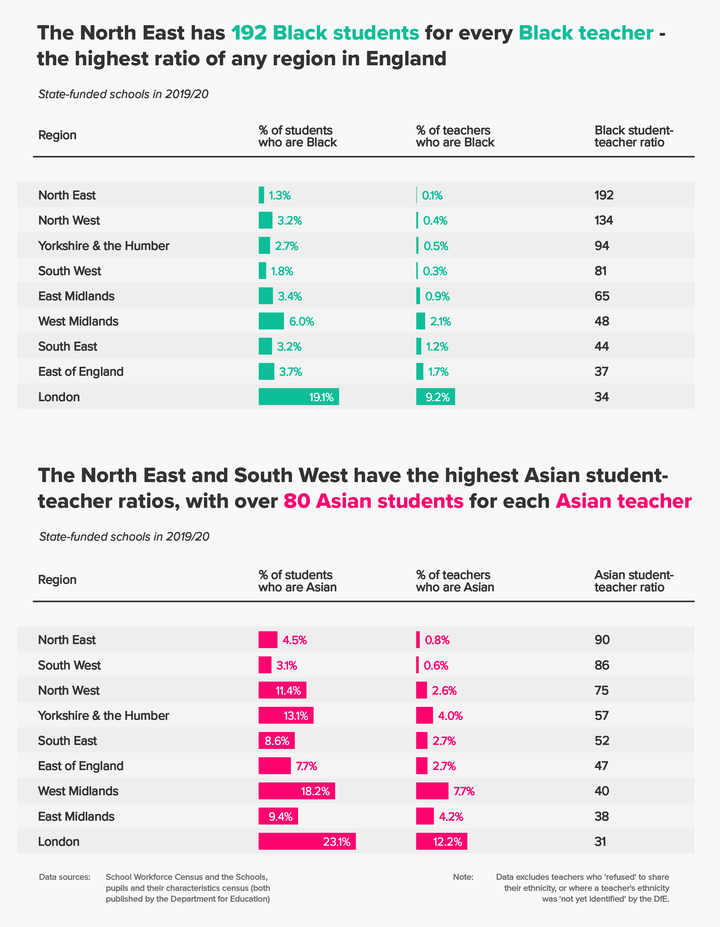
Dr Joseph-Salisbury also said increasing the number of Black and Asian teachers would be insufficient if it was not part of a comprehensive “whole-school approach” to tackling racism.
“As well as getting more people of colour into teaching, we need to make sure that all teachers are equipped to teach in multicultural and multiracial classrooms. That teachers have an understanding of how race and racism works regardless of the racial identity of the teacher.
“If the curriculum is not transformed to look more closely at race and racism, to look at the history and achievements of people of colour, to look at how colonialism has shaped contemporary society it will make only small progress.”
To that end, Chalke set up Break the Cycle in 2019, which organises conferences with the aim to “break the cycle of an education system which doesn’t promote Black history, doesn’t reflect the cohort of students in many schools on the walls of its corridors or in the aspects of its curriculum, and doesn’t create enough access and mentoring for Black and brown students to grow up through the ranks and become leaders”.
A Department for Education spokesperson said: “The teaching workforce is becoming more diverse – with the latest data showing 9.3% of teachers are from Black, Asian and non-white ethnic minority backgrounds, while double that started postgrad teacher training courses this academic year – compared to 14% of England’s working-age population.
“We made diversity a feature of our recruitment and retention strategy and continue to develop programmes that support all teachers, including those from diverse backgrounds.”
